Has Educational Reform Succeeded in Taiwan? 4500-Percent Rise in Cram Schools over Past 30 Years
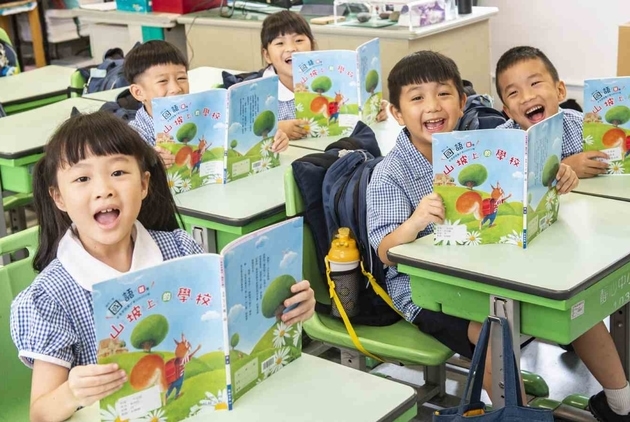
Source:Chien-Ping Huang
The number of Taiwanese students studying abroad has exceeded 40,000 in recent years, with increasing diversity in choice of countries. Nevertheless, despite repeated efforts at educational reform in Taiwan, cram schools continue to proliferate, and the number of students who have interrupted their studies or dropped out due to a disconnect with their interests is also quite high. In light of this, do the new national curriculum guidelines present an opportunity for change?
Views
Has Educational Reform Succeeded in Taiwan? 4500-Percent Rise in Cram Schools over Past 30 Years
By Li Hsun TsaiFrom CommonWealth Magazine (vol. 689 )
Sitting in a coffee shop during winter break, Tai Hsiang-yu’s face lights up underneath his ball cap the moment the subject of university life in Hong Kong comes up. Currently in his second year, after graduating from Chienkuo Senior High School in 2018, he set out to study computer science at the City University of Hong Kong.
While in high school, Tai longed to study abroad (in the West). However, after considering his financial circumstances, and having obtained a full scholarship from the school, he decided to go to Hong Kong, just a 90-minute flight from Taipei. An emphasis on practical application, plus numerous international students and instruction exclusively in English, were key factors for his decision to attend university in Hong Kong.
Now, having completed three semesters, Tai is not in the least disappointed. Reflecting for a moment, he considers that he has become good friends with classmates from Thailand, India, Kyrgyzstan, and Serbia. Starting freshman year, he and his classmates have actively looked for internship opportunities with the school’s assistance to help jumpstart their future job prospects.
Over the past 20 years a steady stream of Taiwanese students like Tai has headed abroad to study after high school and college.
Overseas Studies: Overall Volume Up, Students in USA Down
According to statistics from the Ministry of Education’s Department of International and Cross-Strait Education, the number of Taiwanese students obtaining visas for overseas study increased from 32,000 to 41,000 between 2000 and 2018, representing a 25-percent increase (Table 1).
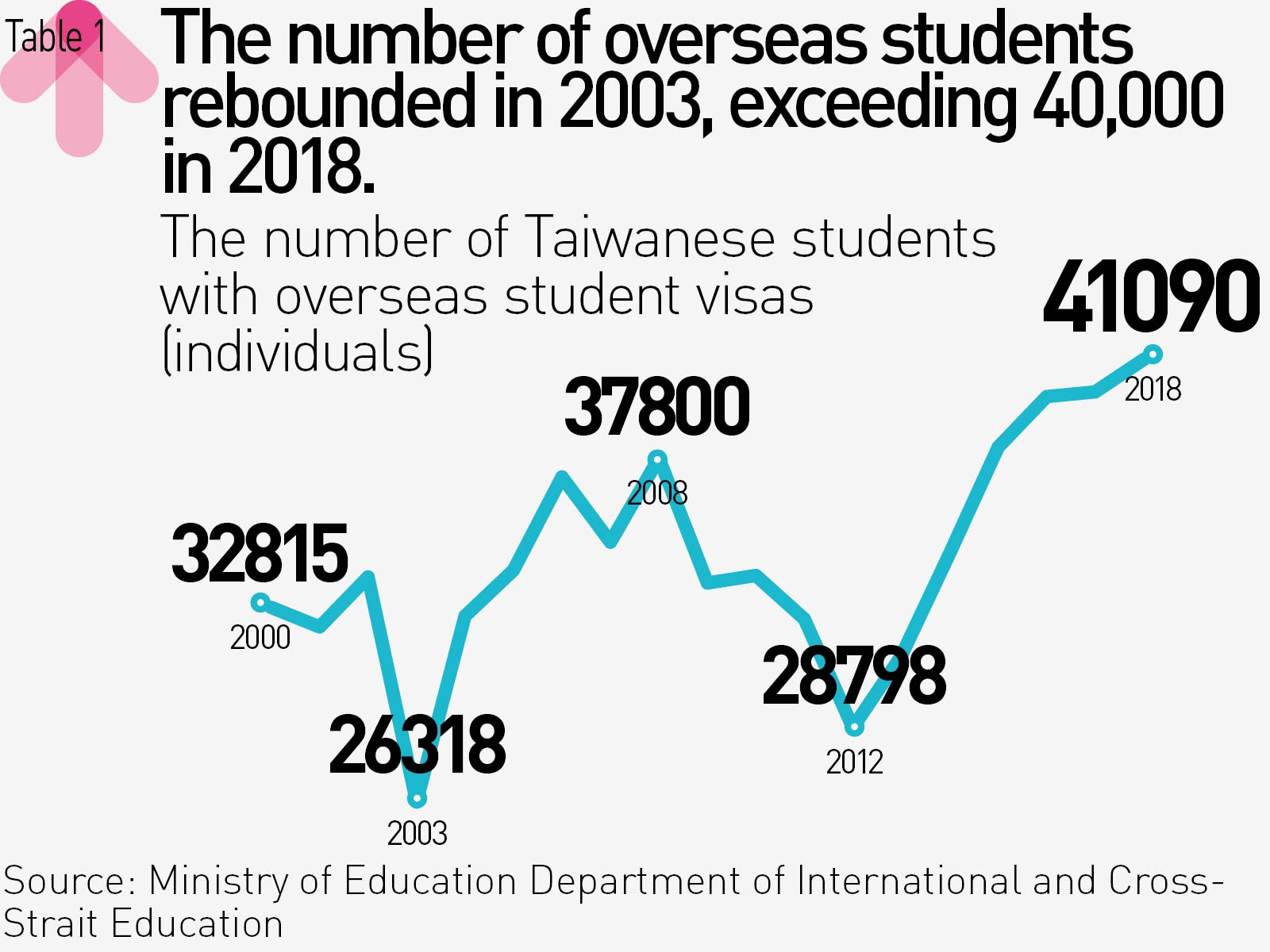
Further analysis indicates that among the destination countries for overseas studies, the United States, with its numerous traditional storied institutions of higher learning, remains the choice of the majority of students; however, those numbers are declining year after year. Meanwhile, such enticements as short-term visas and inexpensive tuition have attracted a steadily increasing number of students to such countries as Japan, Australia, and Germany (Tables 2, 3).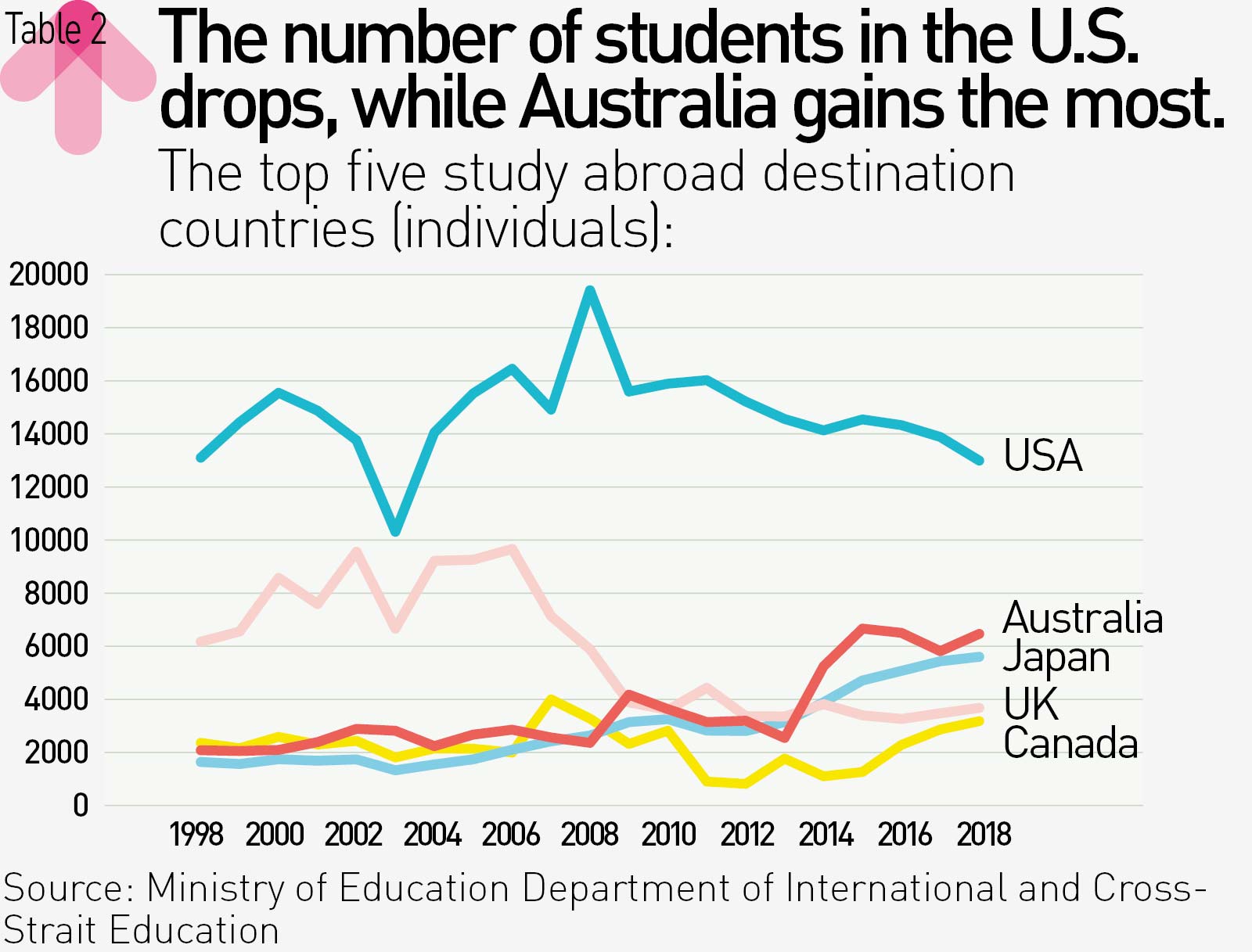
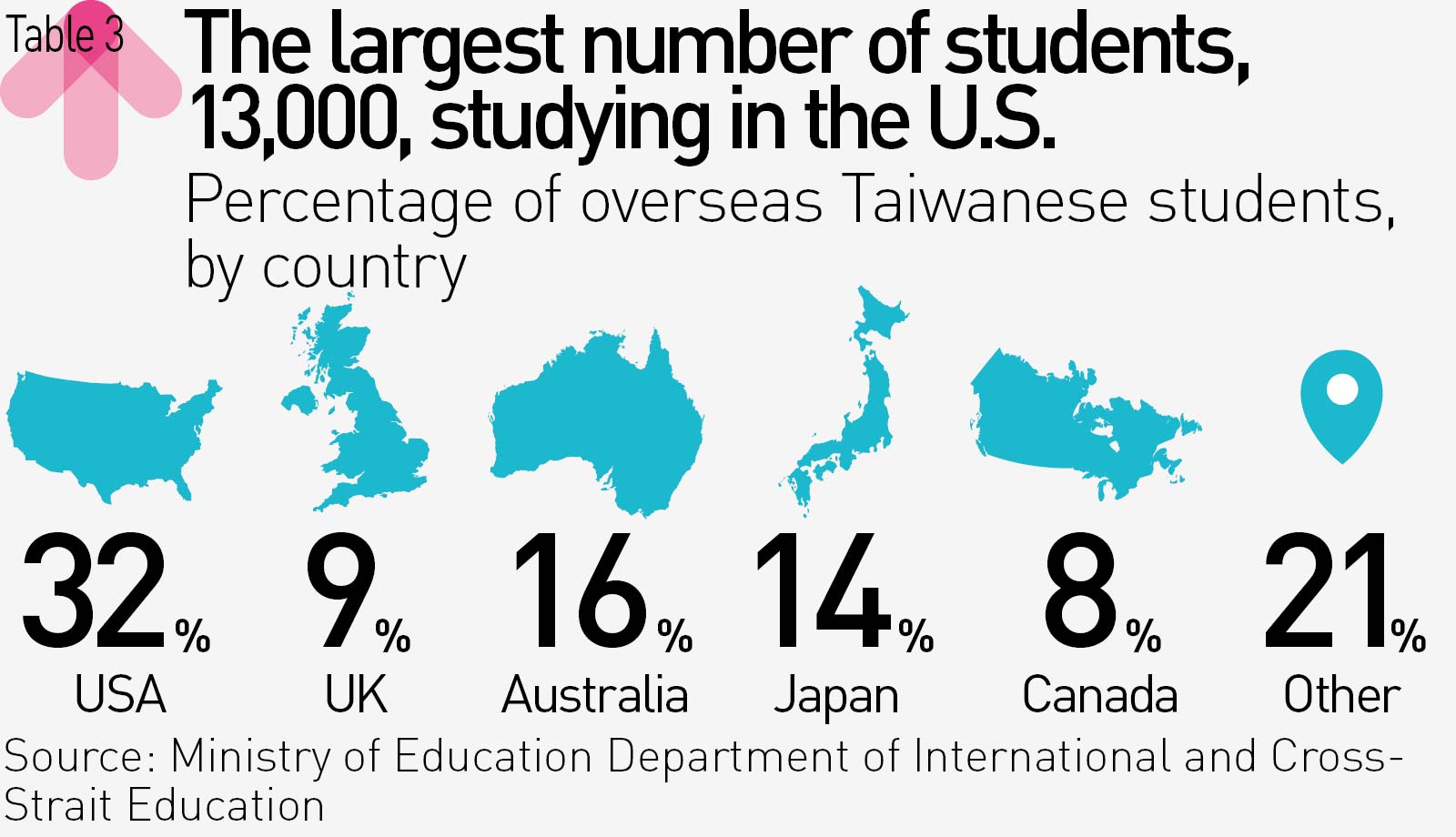
Taking 2018 for example, the number of students heading to Japan for studies was 3.4 times that of 20 years prior, at 5,589 students, while Germany saw a 449 percent increase over the same period. Chen Ya-ping, dean of students at National Taiwan Normal University Senior High School, feels the intensity of the global press to recruit qualified talent.
In recent years there has been a veritable explosion in the number of foreign universities approaching Taiwanese high schools, and their recruiting methods take numerous forms.
During his junior year, Tai Hsiang-yu attended at least 10 informational presentations by overseas universities at Chienkuo Senior High. Under an agreement recently signed between the University of Amsterdam in the Netherlands and NTNU Senior High School, the U of A will automatically accept any two students recommended by the high school each year.
Family support is a direct boost. Chen Ya-ping notes that some parents, concerned about the generally low salary levels in Taiwan, encourage their children to venture abroad as long as they are capable and the family can afford to support them, or if they can get financial aid. If circumstances allow, they are further encouraged to remain abroad to look for employment.
 Renowned universities around the world pull out all the stops in the effort to recruit students. For instance, Tokyo University arranged for visits by Taiwanese high school teachers to learn about various aspects of Japanese culture to better counsel students with potential interest in studying abroad in Japan. (Source: CW)
Renowned universities around the world pull out all the stops in the effort to recruit students. For instance, Tokyo University arranged for visits by Taiwanese high school teachers to learn about various aspects of Japanese culture to better counsel students with potential interest in studying abroad in Japan. (Source: CW)
Talent: How to Create Incentives to Return to Taiwan
From an educator’s perspective, Chen Ya-ping says that students returning to Taiwan after accumulating studies and work experience overseas is not a bad thing. Accordingly, how to create incentives to attract this talent back home while avoiding a long-term brain drain is something to which the government and corporations should give ample consideration.
This generation of children, under their parents’ arrangements, has studied English at school and cram schools from a young age, honing universally better English skills than the previous generation. This is also a contributing factor prompting more students to pursue studies abroad.
Yet it has also led to another phenomenon across Taiwan’s education landscape, namely the continuing rise of cram schools.
Nearly 20,000 Cram Schools, Majority in Humanities and Sciences
According to statistics gathered by the Kaohsiung Education Bureau on behalf of the Ministry of Education, there were 17,000 cram schools in Taiwan in 2018. This was 14,000 more than 20 years earlier (Table 4).

Among these, around 60 percent teach science and the humanities, with the number of schools growing tenfold over 20 years ago. Categorized by student grade level, around 8,800 cram schools are aimed at elementary school students.
Taiwan has a low, sub-replacement fertility rate, yet cram schools keep popping up. This reflects parents’ concern regarding educational reform efforts, and their fervent wishes for their children to get a head start. “When parents lack the ability or time to understand these details, they reason that it’s better to turn to others for help,” observes Professor Wang Li-yun of the NTNU Graduate Institute of Educational Policy and Administration.
 Taiwan abolished the Joint College Entrance Examination system in 2002 in favor of diversified admissions. (Source: CW)
Taiwan abolished the Joint College Entrance Examination system in 2002 in favor of diversified admissions. (Source: CW)
In Taichung in particular, many children start going to cram school in third grade to study English, mathematics and Chinese in preparation for private middle school entrance examinations in sixth grade in hopes of getting into a well-known middle school. According to a survey conducted by Parenting magazine in Taichung in 2018, over 80 percent of middle school students took cram school classes during elementary school.
High University Dropout and Leave Rate Due to Lack of Interest
“Everybody says university students are lackadaisical about classes, but many are actually quite [confused] about their future. They spend so much time in junior and senior high school preparing for examinations that they have no time to explore their own interests,” relates a Taiwanese exchange student in Germany. The student was shocked at how attentive German students were in class, with barely anyone checking their mobile phones or nodding off.
According to Ministry of Education statistics, only 4.63 percent of Taiwanese university students took leaves of absence or dropped out in 2000. That percentage had climbed to 11.06 percent in 2017, to around 90,000 students. The main justification for 28.4 percent of them was that their studies did not reflect their interests (Table 5).
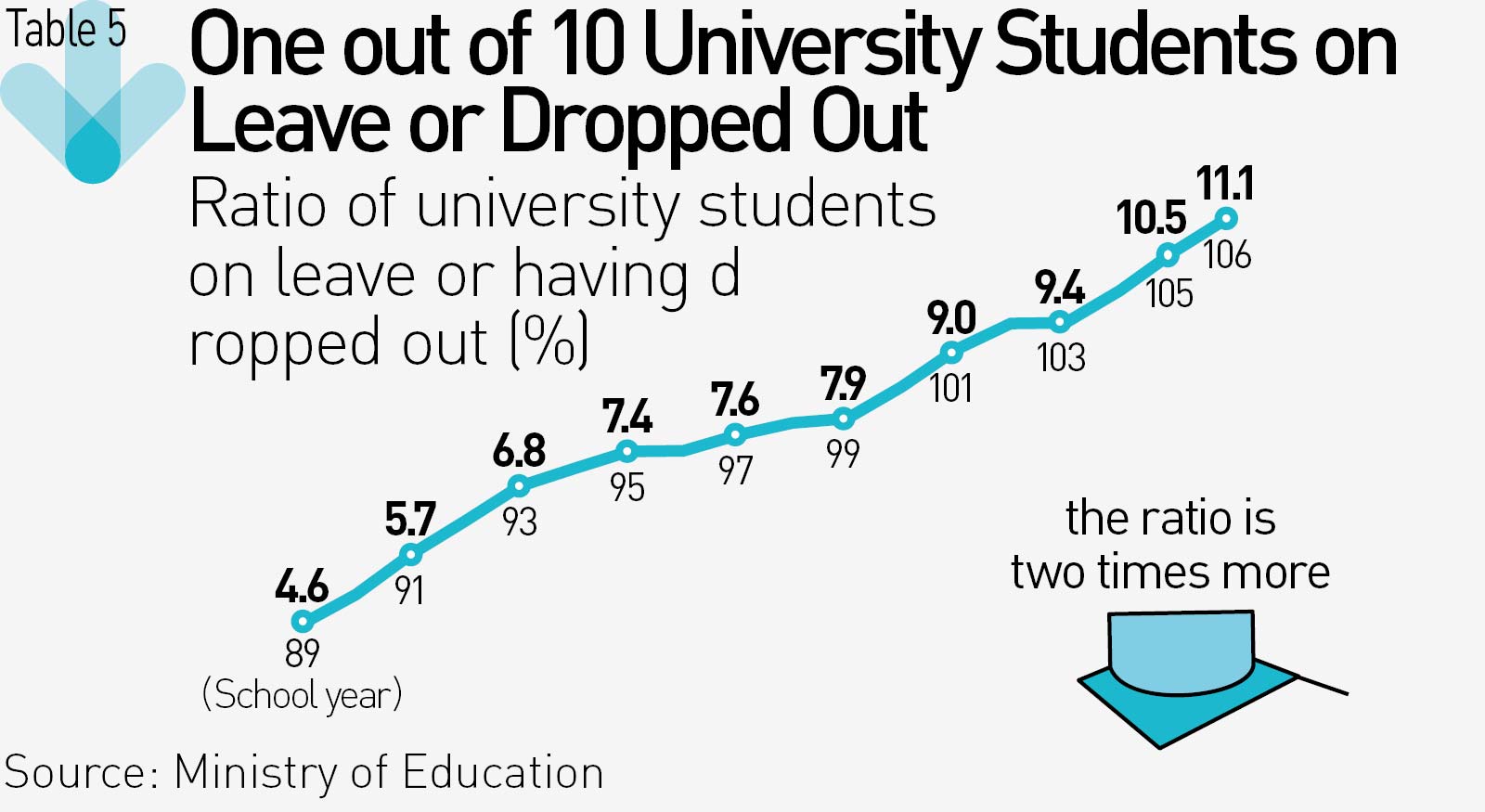
In light of her good grades, at the suggestion of her parents, Huang Hsuan-yu, now 29, began studying Spanish at National Chengchi University’s College of Foreign Languages and Literature. However, she had always kept the dream of fashion design in her heart, and she couldn’t take it any longer by her junior year. After a discussion with her parents, she applied to the Parsons School of Design in New York, took a leave of absence from NCCU, and departed to start college all over again in the United States.
Most Taiwanese students pursuing university degrees abroad due to incompatibility between their studies and interests at home nonetheless retain their Taiwan university eligibility while arranging to take a leave of absence. That way, they have a fallback option if things do not work out abroad. An example is Tai Xiang-yu retaining his student status in NTU’s computer science department.
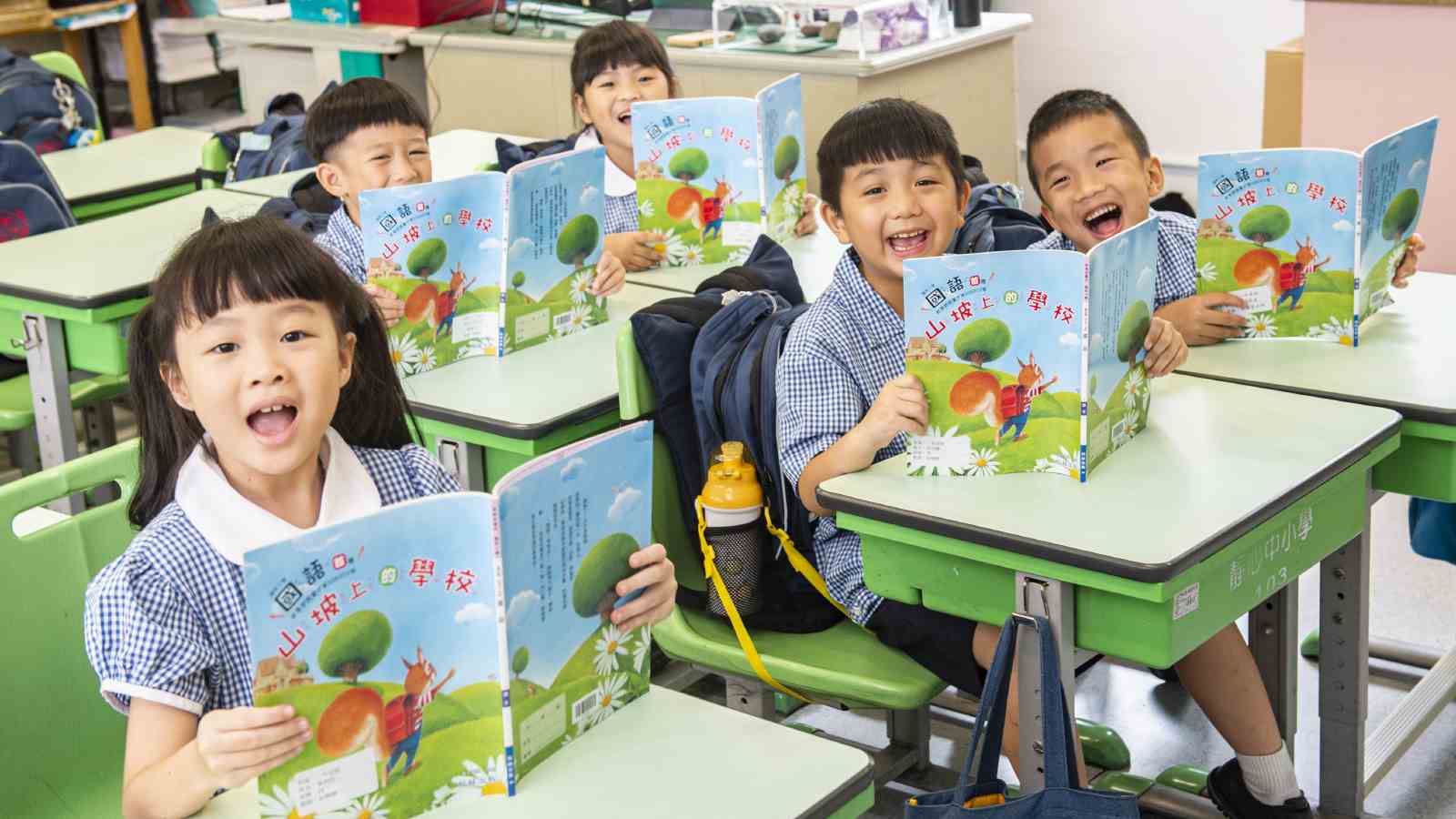 Following the implementation of 12-year Fundamental Citizens’ Education in 2019, the 2020 curriculum guidelines were introduced. (Photo by Chien-Ping Huang)
Following the implementation of 12-year Fundamental Citizens’ Education in 2019, the 2020 curriculum guidelines were introduced. (Photo by Chien-Ping Huang)
Some students take a leave during what would have been their freshman year of college to take what is known as a “gap year” for learning while traveling. “Then, upon returning to university, the motivations for study are clearer,” says Professor Henry Horng-shing Lu, president for academic affairs at National Chiao Tung University.
As for the students who stay in school, more and more fit the description of “Generation Apathy.” “Those who stick around take more time (to graduate), and attention should be paid to how they conduct their studies, as in how many are just hanging on until they finish?” says Wang Li-yun.
The 2019 Curriculum Guidelines, on line since August 2019, stress the individuality and independence of every student, and aim to give students autonomy over their studies so as to find things that spark their motivation to learn. This will be an important direction for education in Taiwan over the coming decade.
Taiwan Milestones
Education Professionals
1994 April 10 street demonstrations headline Taiwan’s first movement for educational reform.
2002 The Joint University Entrance Examination is abolished in favor of diversified admissions; “official standard texts” edited by the Ministry of Education become a thing of the past as Taiwan enters an era of “one curriculum guideline, multiple texts.”
2004 In September, the Ministry of Education begins promoting the Grade 1-9 Curriculum Guidelines.
2017 The Ministry of Science and Technology unveils the LIFT (Leaders in Future Trends) program to attract talent to return to Taiwan from overseas; The Ministry of Education introduces public funding for students studying in Southeast Asian countries.
2018 The Ministry of Education establishes the SIT (Study in Taiwan) talent database project, a platform of university alumni remaining in Taiwan.
2019 Implement 12-year citizens fundamental education program, with the 2019 curriculum guidelines go into effect.
Translated by David Toman
Edited by TC Lin, Sharon Tseng












